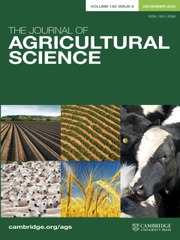No CrossRef data available.
Article contents
Cropping pattern effects on water supply-demand balance in a traditional irrigation network of a semi-arid region of Iran
Published online by Cambridge University Press: 19 March 2025
Abstract
Agriculture, as the largest consumer of freshwater, plays a crucial role in managing limited water resources. However, uncertainties in water supply, particularly in water-scarce regions, hinder further agricultural development. Balancing agricultural development with environmental sustainability is especially demanding in the Karkheh River Basin (KRB), western Iran. Traditional irrigation networks in the upper KRB are inefficient, exacerbated by unregulated water use and over-extraction. This study explores the Water Supply-Demand Balance (WSDB) dynamics under current cropping patterns in the semi-arid Honam sub-basin of the upper KRB. Time-series Landsat imagery and Machine Learning (ML) algorithms classified crop types and estimated major crop cultivation area during 2019-2021. Regional Crop Water Requirement (ETcreg) and Regional Net Irrigation Requirement (INETreg) estimated the Regional Gross Irrigation Water Demand (GIWDreg), while inflow-outflow analyses determined Surface Irrigation Water Supply (SIWS). The study achieved high crop classification accuracy, facilitating precise water demand estimation across large-scale traditional irrigation networks. Results indicated the highest GIWDreg in 2020 (11.3 × 106 m3/year), driven by increased forage cultivation with crop water requirements (ETc) exceeding 1000 mm. That year also recorded the maximum SIWS (14.8 × 106 m3/year). The Water Scarcity Index (WSI) classified shortages as severe to extreme, indicating WSDB instability due to drought and cropping pattern shifts. This study highlights the necessity for government initiatives promoting water-efficient cropping to align agriculture with water availability. The proposed approach offers practical insights for policymakers seeking to optimize food security while ensuring sustainable water management in traditional irrigation networks, where cropping patterns are difficult to assess.
Keywords
- Type
- Climate Change and Agriculture Research Paper
- Information
- Copyright
- The Author(s), 2025. Published by Cambridge University Press


